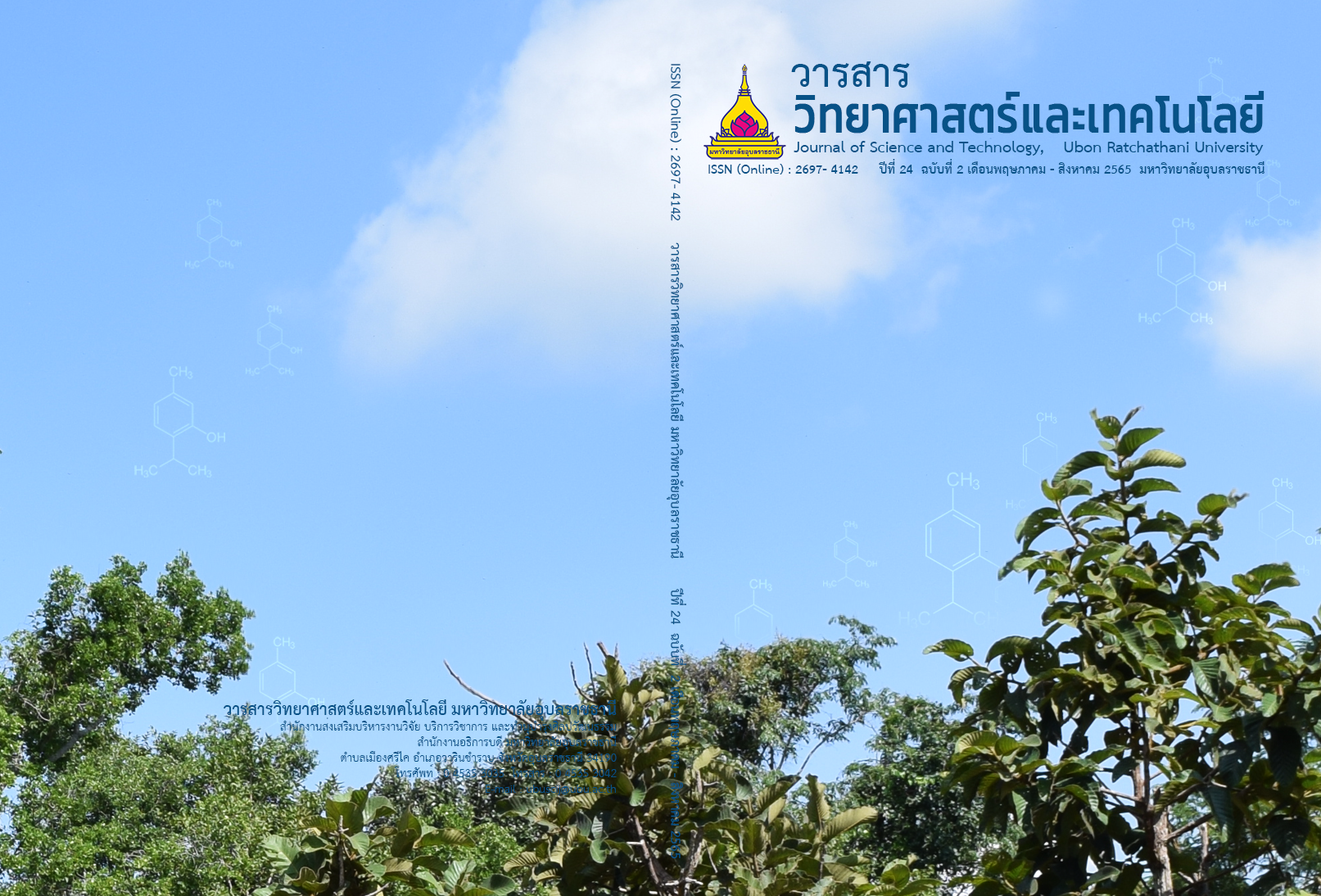การพัฒนาผลิตภัณฑ์บาร์บีคิวรสพริกไทยดำจากเนื้อปลาสวาย
Main Article Content
บทคัดย่อ
งานวิจัยนี้มีวัตถุประสงค์เพื่อพัฒนาผลิตภัณฑ์บาร์บีคิวรสพริกไทยดําจากเนื้อปลาสวาย (Pangasius hypophthalmus) เพื่อเพิ่มมูลค่าให้กับปลาสวาย โดยผลิตภัณฑ์ตั้งต้นมีส่วนประกอบดังนี้ เนื้อปลาสวายร้อยละ 45.0 ซอสพริกร้อยละ 9.0 ซอสมะเขือเทศ ร้อยละ 9.0 น้ำตาลทราย ร้อยละ 9.0 พริกไทยดำร้อยละ 13.0 ซอสถั่วเหลืองร้อยละ 4.5 รากผักชีร้อยละ 5.0 และกระเทียมร้อยละ 5.5 ตามลำดับ ทำการทดสอบคุณภาพทางประสาทสัมผัสของผลิตภัณฑ์ตั้งต้นด้วยวิธี hedonic 9-point scale แล้วปรับปรุงผลิตภัณฑ์โดยการเพิ่มปริมาณกระเทียมและรากผักชีเป็นร้อยละ 6.0 และลดปริมาณซอสถั่วเหลืองเป็นร้อยละ 3.0 พบว่าผลิตภัณฑ์ที่ได้รับการปรับปรุงแล้วได้รับคะแนนความชอบ ด้านลักษณะปรากฏ สี กลิ่น รสชาติ เนื้อสัมผัสและความชอบโดยรวมเท่ากับ 7.90 ± 0.55, 8.05 ± 0.51, 7.65 ± 0.49, 7.95 ± 0.39, 8.10 ± 0.45 และ 8.00 ± 0.32 ตามลำดับ ซึ่งคะแนนความชอบที่ได้ในทุกคุณลักษณะที่ทดสอบมีค่าสูงกว่าคะแนนความชอบของผลิตภัณฑ์ตั้งต้น อย่างมีนัยสำคัญ (p≤0.05) ภาพรวมของผลิตภัณฑ์ที่ได้รับการปรับปรุงมีคะแนนอยู่ในระดับชอบปานกลางถึงชอบมาก แสดงให้เห็นว่าผลิตภัณฑ์บาร์บีคิวรสพริกไทยดำจากเนื้อปลาสวายเป็นที่ยอมรับของผู้บริโภคและเป็นทางเลือกในการนำเนื้อปลาสวายที่มีกลิ่นคาวและราคาตกต่ำไปแปรรูปเพื่อเพิ่มมูลค่า
Article Details

อนุญาตภายใต้เงื่อนไข Creative Commons Attribution-NonCommercial-NoDerivatives 4.0 International License.
บทความที่ได้รับการตีพิมพ์เป็นลิขสิทธิ์ของ วารสารวิทยาศาสตร์และเทคโนโลยี มหาวิทยาลัยอุบลราชธานี
ข้อความที่ปรากฏในบทความแต่ละเรื่องในวารสารวิชาการเล่มนี้เป็นความคิดเห็นส่วนตัวของผู้เขียนแต่ละท่านไม่เกี่ยวข้องกับมหาวิทยาลัยอุบลราชธานี และคณาจารย์ท่านอื่นๆในมหาวิทยาลัยฯ แต่อย่างใด ความรับผิดชอบองค์ประกอบทั้งหมดของบทความแต่ละเรื่องเป็นของผู้เขียนแต่ละท่าน หากมีความผิดพลาดใดๆ ผู้เขียนแต่ละท่านจะรับผิดชอบบทความของตนเองแต่ผู้เดียว
เอกสารอ้างอิง
Fish marketing Organization. 2014. Fisheries Record 2014. https://fishmarket.co.th. Accessed 2 May 2022. (in Thai)
Treeinthong, J., Kamhong, R. and Phookramorn, W. 2019. Product development of fish ball from striped catfish (Pangasianodon hypophthalmus). Khon Kaen Agriculture Journal. 47(Suppl. 2): 461-466.
Orban, E. and et al. 2008. New trends in the seafood market. Sutchi catfish (Pangasius hypophthalmus) fillets from Vietnam: Nutritional quality and safety aspects. Food Chemistry. 110(2): 383-389.
Department of Fisheries. 2020. Thai Fish with High Omega-3. https://wwwfisheries.go.th/index. php/dof/news_local/16/77888#img-link. Accessed 19 January 2022. (in Thai)
Department of Fisheries. 2020. Fisheries Statistics of Thailand 2018. https://opendata.nesdc.go.th/ dataset/74fba229-ed6e-4cbf-8f0c-5d26893f6f93/ resource/75f18e78-6a9b45e1b2236f481f6b575b/ download/-2561.pdf. Accessed 29 January 2022. (in Thai)
Miller, T. 2014. Barbecue: A History. Maryland: Rowman & Littlefield Publishers.
Krua Baan Pim. 2017. Barbeque Seafood in Thai Style. https://www.pim.in.th/snack/ 1120-seafood-bbq. Accessed 4 June 2017. (in Thai)
Theprugsa, P., Kaewsaat, T. and Suwonsichon, S. 2011. Developing production process and upgrading quality of seasoning beef jerky. Thai Science and Technology Journal. 19(2): 40-50. (in Thai)
Liu, S. and et al. 2017. Exploration of volatile compounds causing off-flavor in farm-raised channel catfish (Ictalurus punctatus) fillet. Aquaculture International. 25(1): 413-422.
Sae-leaw, T. and et al. 2013. Changes in lipids and fishy odor development in skin from Nile tilapia (Oreochromis niloticus) stored in ice. Food Chemistry. 141(3): 2466-2472.
Yamprayoon, J. and Noomhorm, A. 2000. Effects of preservation methods on geosmin content and off-flavor in Nile tilapia (Oreochromis niloticus). Journal of Aquatic Food Product Technology. 9(4): 95-107.
Wongwiwat, P., Yanpakdee, S. and Wattanachant, S. 2007. Effect of mixed spices in lemon glass marinade cuisine on changes in chemical physical and microbiological quality of ready-to-cook Thai indigenous chicken meat during chilled storage. Songklanakarin Journal of Science and Technology. 29(6): 1619-1632. (in Thai)
Anassori, E. and et al. 2011. Garlic: A potential alternative for monensin as a rumen modifier. Livestock Science. 142(1-3): 276-287.
Aguirrezabal, M.M. and et al. 1998. Compounds of technological interest in the dry sausage manufacture. Sciences des Aliments. 18: 409-414.
Lawrence, R. and Lawerence, K. 2011. Antioxidant activity of garlic essential oil (Allium sativum) grown in north Indian plains. Asian Pacific Journal of Tropical Biomedicine. 1(1): 51-54.
Khaka, A. 2017. Phytochemicals from Piper nigrum and their pharmacological effects. PKRU SciTech Journal. 1(2): 28-39. (in Thai)
Kasahara, K. and Osawa, C. 1998. Combination effects of spices on masking of odor in boiled sardine. Fisheries Science. 64: 415-418.
Yoshida, A., Sasaki, K. and Ohshiba, K. 1984. Suppressing experiments for fishy odor. II. Effects of spices, seasonings and food additives for fishy odor and volatile carbonyl compounds. Seikatsu Esei. 28: 211-218.
Kikuchi, T., Hirai, K. and Sudarso, A.S. 1968. Suppressing effect of spice for fishy odor: A model experiment with the mixture of trimethylamine and spice. Eiyo to Shokuryo. 21: 253-256.
Muninnopamas, W. and Phalachai, P. 2015. Development on garlic black pepper flavoured palaw keropok. RMUTSV Research Journal. 7(1): 15-27. (in Thai)
Hoque, M.S. and et al. 2021. Effects of Pangasius (Pangasius hypophthalmus) and Skipjack Tuna (Sarda orientalis) mince blend on the quality of fish products: Ways to utilize resources and nutrition in Bangladesh. Food Science and Nutrition. 9: 6642-6652.
Khaedon, U. and et al. 2019. Study on developing floss pangasius to be quality instant food. In: Proceedings of the 1st National Conference on Vacational and Technology, 9 March 2019. Phisanolok, Thailand. (in Thai)


